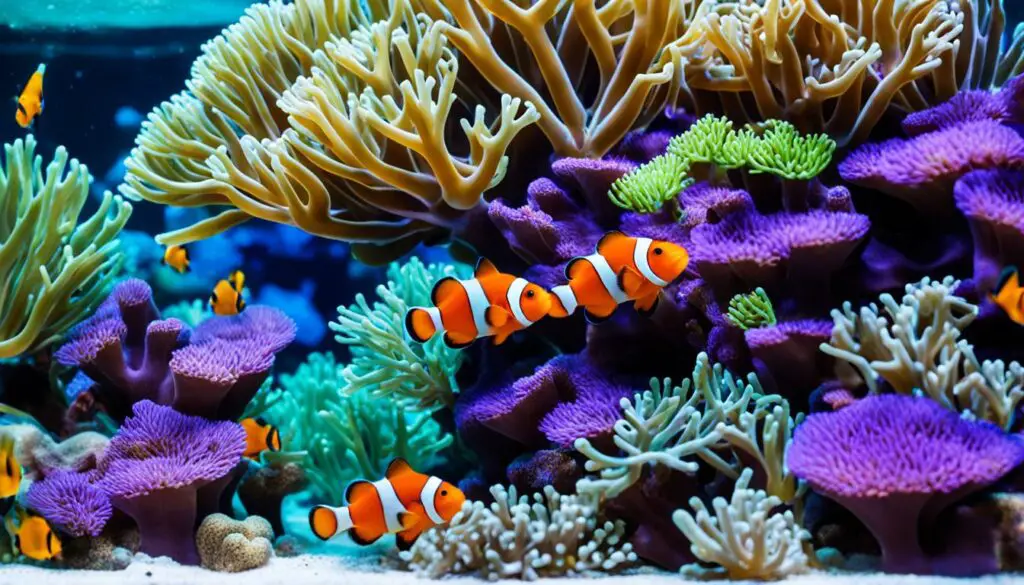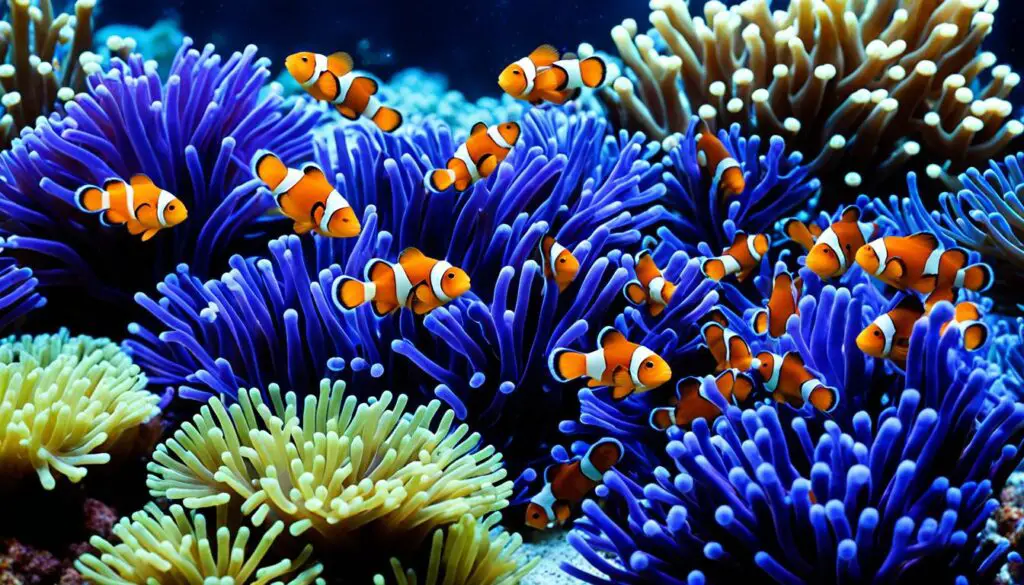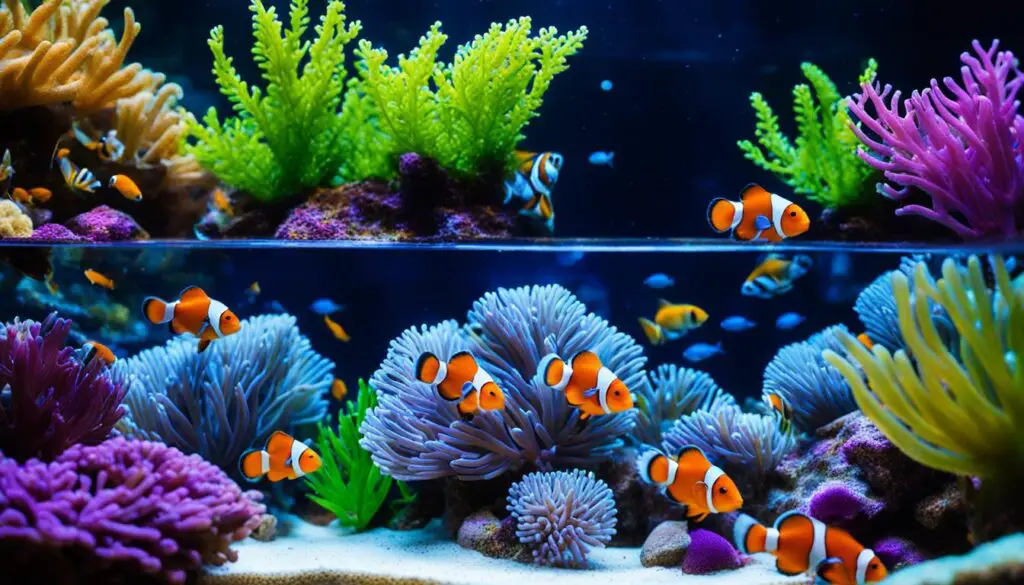Clownfish Tank Essentials: Everything You Need to Know
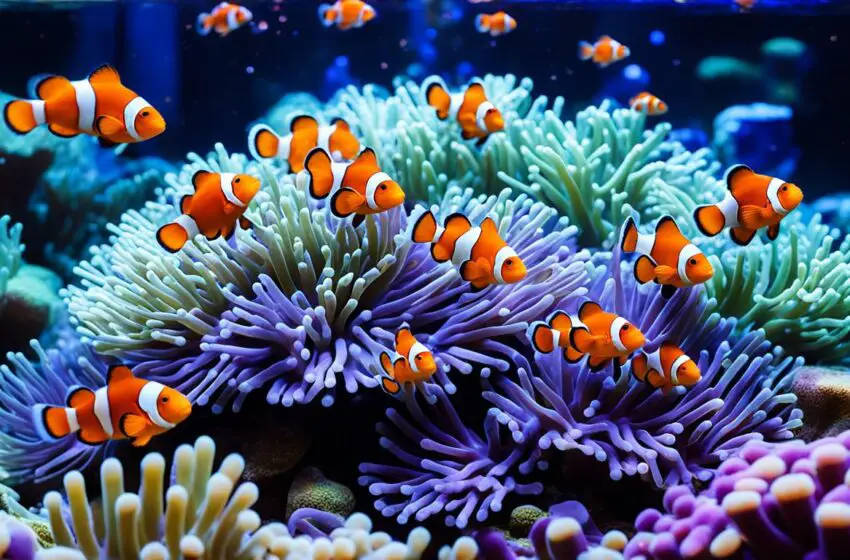
Welcome to our guide on clownfish tank essentials! This article will give you all you need. I’ll help you create a perfect home for these bright, cute fish. It’s perfect for both new and expert fish keepers.
Clownfish are famous for their vibrant colors and fun characters. They share a special relationship with sea anemones. The anemones give them a safe home, and the clownfish keep them clean. It’s a win-win that’s amazing to watch.
For your clownfish to be happy, they should live in pairs or groups. They love being around others of their kind. Make sure to give them friends in their tank to make them feel at home.
When picking clownfish for your aquarium, choose aquacultured ones. This choice helps keep the ocean safe. It also means your fish will be stronger and do better in tanks.
Key Takeaways:
- The clownfish-sea anemone bond is an interesting part of their life.
- Clownfish are happiest when with a friend or two because they are very social.
- Choosing aquacultured clownfish helps protect the ocean and gives you healthier pets.
- To make a great home for your clownfish, add friends and make sure their tank is just right.
- Next, we’ll show you how to set up a perfect home for your clownfish. So, keep reading!
Setting up a Clownfish Tank
Want to bring the ocean’s colors to your home? Start with a clownfish tank. Setting one up the right way is essential for your fish’s health and happiness.
Gather the Minimum Equipment Required
To start, you’ll need some basic gear:
- A tank with a minimum size of 30 liters to provide enough space for the clownfish to swim and thrive.
- A specialized sea salt mix to recreate the natural marine environment.
- Sea sand, which serves as the substrate for the tank.
- Live rock, which provides hiding spots for the clownfish and promotes the growth of beneficial bacteria.
- A filter to remove waste and maintain water quality.
- A circulation pump to ensure water movement and prevent stagnant areas within the tank.
- A heater to maintain a stable temperature suitable for the clownfish.
- Proper lighting to simulate a natural day-night cycle.
- Water testing kits to monitor and maintain the appropriate water parameters.
The Tank Setup Process
With all your gear ready, let’s set up the tank:
- Cleaning the tank: Make sure your tank is squeaky clean. No dirt or harmful stuff should be left behind.
- Positioning the tank: Put the tank somewhere not in direct sunlight. This helps prevent too much algae and keeps the temperature steady.
- Adding sand: Lay sea sand at the tank’s base. This makes the tank feel more natural for the clownfish.
- Filling the tank with saltwater: Mix sea salt with water as directed. Pour it in slowly without disturbing the sand. Fill to the right level.
- Adding necessary equipment: Put in the filter, pump, heater, and lights following the instructions that came with them.
- Allowing for cycling: A natural cleaning process happens next. This step is important for your clownfish’s good health. It will take a few weeks, but it’s worth waiting.
- Testing water parameters: Keep checking the water to make sure it’s just right for your clownfish. Adjust to keep them healthy.
- Introducing the clownfish: When everything checks out and your tank is stable, it’s time to add your clownfish.
Now your tank is ready. Remember to watch the water, take good care of the tank, and feed your clownfish well. Enjoy the beauty and fun your tank brings to your home.
Maintaining a Clownfish Tank
Keeping a clownfish tank clean is key to keeping fish healthy and water clear. You should do a few tasks every day to make this happen.
1. Daily Tasks
Every day, check the tank’s temperature and if the pump is working. It’s crucial the water isn’t too hot or cold for clownfish. Also, make sure the pump pushes water around well.
Feeding clownfish daily ensures their health. They eat many things, like flake or pellet foods. Add some treats like shrimp, but be careful not to feed them too much. Overfeeding can make the water dirty.
2. Weekly Tasks
Changing some of the water each week is very important. This removes bad stuff and adds good stuff back into the tank. Use a water conditioner to make the new water safe for the fish.
Don’t forget to clean the filter every week. Take out any dirt from the filter to keep it working well. This keeps the water clean.
Testing the water’s quality each week is also a must. Checking the pH and ammonia levels with test kits helps you find any problems. Then, you can fix them before they harm your fish.
3. Establishing a Healthy Bacteria Colony
Having a lot of good bacteria is vital for a healthy tank. These bacteria turn ammonia into nitrate, which is less harmful. Live rock can be their home and help keep your tank in balance.
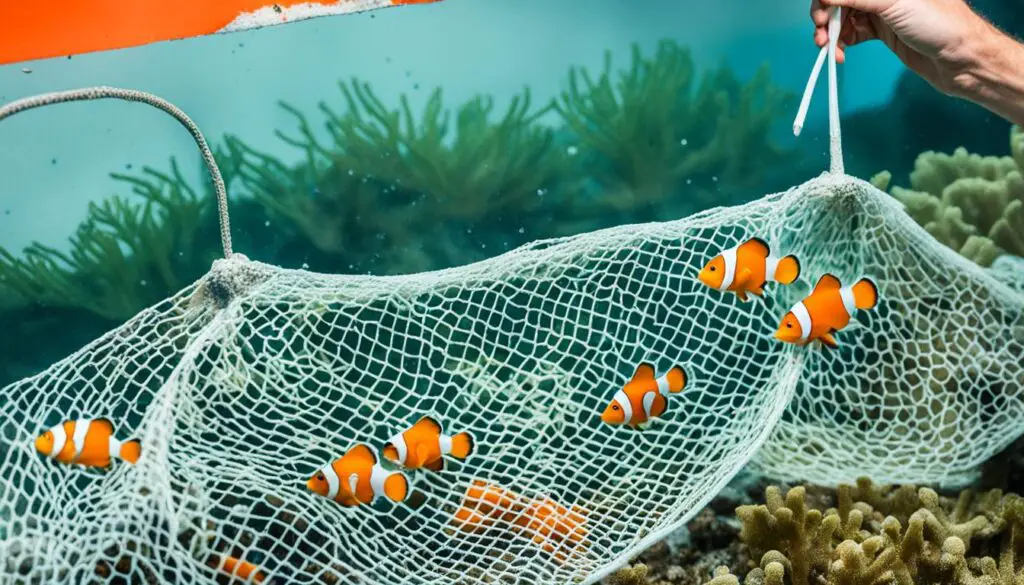
| Task | Frequency |
|---|---|
| Check temperature and pump function | Daily |
| Feed the fish | Daily |
| Perform water changes | Weekly |
| Clean the filter | Weekly |
| Test water parameters (pH, ammonia) | Weekly |
By keeping up with these tasks, your clownfish will thrive. They will show off their bright colors and fun personalities for a long time.
Why Clownfish are Ideal for Beginner Aquarists
Looking to begin your marine adventure? Consider clownfish as your starting point. They are easy to care for, making them a great choice for new fish owners. They don’t need much and can teach you a lot about fish care.
Their easy-care nature makes clownfish a top pick for beginners. They can thrive in different tank setups. Plus, they are not too bothered by small changes in water conditions.
Clownfish are tough little fish. They often avoid common illnesses, which means you won’t have to worry as much about their health.
You don’t need a huge tank for clownfish; 30 liters is enough for a small group. This makes it easier to fit them into your home without taking up too much space.
“Clownfish are playful and interactive creatures, making them enjoyable for the whole family. Their vibrant colors and unique behaviors bring life and entertainment to any aquarium.”
Keeping clownfish is good for more than just their simple care and tank needs. It can be a great way for kids to learn about fish life and care. It also helps teach them why ocean protection is so important.
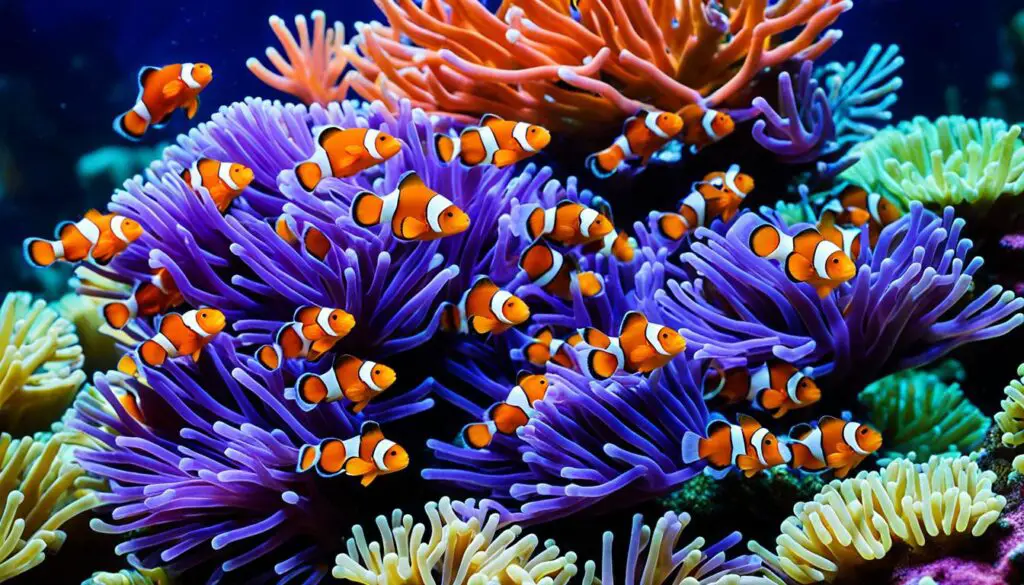
Educational Benefits of Keeping Clownfish
- Teaches children about fish behavior
- Promotes an appreciation for reef life and conservation efforts
- Encourages responsibility and caretaking skills
- Provides opportunities for hands-on learning and observation
Choosing captive-bred clownfish is also good for the wild populations. It is a more responsible choice because it doesn’t harm natural reefs. By doing this, you help protect the oceans while enjoying your fish.
In conclusion, clownfish are a top pick for new aquarists. With their low maintenance, resilience, and their educational benefits, they are a win-win. So, start your journey with these colorful fish today!
Conclusion
Setting up and keeping a clownfish tank needs careful work and constant care. It might look scary, but it’s not. With the right gear and know-how, it can be very satisfying.
Clownfish are amazing and pretty fish. They add joy and learning to your house. Their bright colors and fun ways will fascinate kids and grown-ups. Watching how they act and their tie with sea anemone gives insight into ocean life’s balance.
Taking care of the fish well is very important. Choosing captive-bred clownfish means they will be stronger and help save the wild ones. Picking aquacultured clownfish helps protect ocean reefs and lessen damage to nature.
FAQ
Can clownfish be kept in a community tank with other fish?
Yes, you can put clownfish in a tank with other fish. Just make sure the other fish are friends with the clownfish. Do some research on the fish you want to add. See if they get along well with clownfish. This will help your tank stay peaceful.
How many clownfish should I keep in a tank?
You should keep at least two clownfish together. They like having company. This can lower how much they fight.
Where should I position my clownfish tank?
Place the tank where it won’t get direct sun. This helps keep the water’s temperature steady and stops too much algae. Also, make sure the spot is safe. The tank should not be easy to knock over.
How often should I clean my clownfish tank?
Keep the tank clean for your clownfish. Do weekly tasks like changing the water, cleaning the filter, and checking the water’s quality. Also, every day, make sure the temperature and pump are working right. This keeps your fish happy and healthy.
Can I keep clownfish in a small tank?
Clownfish do well in a 30-liter tank or more. They need space to be healthy. A bigger tank is better. It means the water quality and temperature stay more steady.

